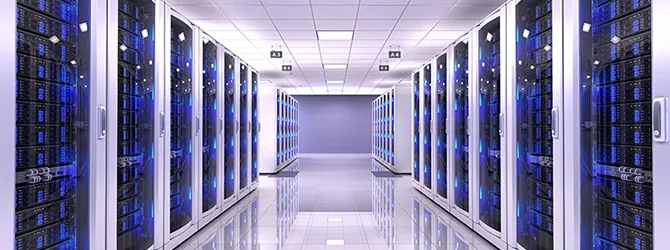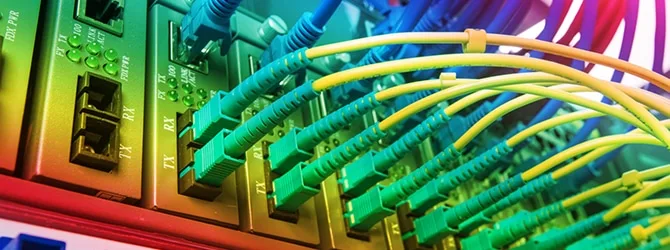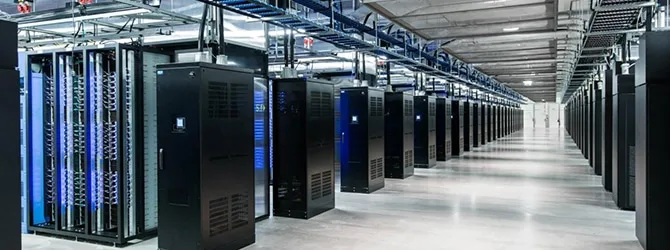Server Room Requirements: Costs To Consider Before Building A Server Room

Virtually every modern business needs servers to run their website, manage email, or deploy cloud applications. In the past, that meant building and equipping an onsite server room.
Today, it usually means leasing or colocating servers in an offsite enterprise-grade data center. But some businesses still choose to invest in building their own server room.
Occasionally, that decision is justified, but for many businesses, dedicated server hosting with a company like ServerMania rather than managing a server room themselves makes more sense financially, technologically, and from a business perspective.
In this article, we’ll examine server room requirements and costs, before discussing some of the reasons why outsourcing server deployment and data center management to ServerMania is the better choice.
See also: 10 Gbps Unmetered Dedicated Servers
Server Room Space

The first aspect to consider when setting up a server room in your office is where the servers will be located. Finding suitable space within a company’s existing property for an onsite server room can be an expensive proposition, often requiring significant remodeling and potentially the construction of a custom space.
The location must be suitable for the installation of bulky power, air conditioning, and networking equipment. It must be able to bear the weight of heavy equipment. Tight spaces aren’t suitable because effective cooling requires the constant circulation of air. It’s also not advisable to build a server room in a windowed space or a space with an external wall, both of which can make it difficult to control and secure the environment within the server room.
Ideally, the space’s ceilings should be at least nine feet from the ground, and raised ceilings are preferred to allow for the running of air ducts and installation of heat exhausts and other equipment. Raised floors that allow for cable runs are also a bonus, but not necessary for smaller server rooms.
Above all, a server room must be secure, with monitored and controlled access from within the building and from external areas.
See also: How To Choose The Best Server for A Small Business
Server Room Equipment
Once a location has been selected, it’s time to consider the equipment that is to be purchased and fitted. Much of the expense associated with building a server room is generated by the equipment needed to support servers, rather than the servers themselves.
Air Conditioning
Air conditioning for server rooms has three main tasks:
- Maintenance of stable temperatures in the server room.
- Humidity control: servers don’t do well in humid environments.
- Air filtration: dust and other airborne particles can reduce the lifespan and reliability of computing equipment.
Typically, smaller server rooms will use wall-mounted air conditioners. For larger rooms under-ceiling units are preferable.
Temperatures within a server room should be approximately 71°F (22°C). Modern servers will function at higher temperatures, but with an increased likelihood of component failure.
Fire Suppression
Servers represent a significant capital investment even before the data stored on them is taken into account. Server room fire suppression equipment uses gas or chemical suppression techniques to automatically extinguish fires. Most fire suppression systems require pressure relief venting to be fitted to server rooms to mitigate pressure changes during discharge.
Racks
Modern servers are designed to be mounted in racks. Servers are available in a wide range of sizes, expressed as multiples of a rack unit (or “U”). The smallest server rooms will require at least one cabinet or rack, which will contain space for servers. The larger the server deployment, the more racks and cages you’ll need.
Networking

Depending on the number of servers the server room will house, you can expect to require:
- core routers
- switches
- appropriate cabling
Networking equipment should be housed in a secure equipment rack within the server room. The type of networking equipment needed depends on the number of servers, the desired levels of redundancy, and a number of other factors.
For smaller server rooms, router/firewall combination devices are available and it may be possible to use a dedicated server with a specialist Linux distribution like PFSense. Larger server rooms require dedicated routers; Cisco and Juniper are the leading manufacturers of networking equipment. Businesses that depend on the reliability of their server room should choose to double-up on networking equipment for redundancy.
See also: Server Clusters
Power
Your server room requires a reliable power supply. At minimum the server room requires a utility power source, but plugging servers directly into utility power is not a good idea.
For reliability, an Uninterruptible Power Supply (UPS) is required. A UPS provides emergency power for short periods in the event of a mains power failure. Servers need a consistent supply of power and mains power is prone to occasional brownouts or blackouts. Without a UPS, servers are at risk of data corruption, equipment damage, and availability issues.
The UPS typically provides power to a power distribution unit (PDU) mounted within the server rack that houses the servers they power.
Once again, redundancy is an important concern here. A UPS is only a temporary solution to power outages, and for optimal reliability, multiple power sources that include an on-site generator are preferred.
Security
Security should be a core priority, especially if an organization stores and processes sensitive data. Server room security is a major component of most regulatory frameworks governing data storage, including HIPAA for private medical data and PCI DSS for credit card data.
Physical security equipment required might include:
- Heavy duty doors with electronic locks.
- CCTV monitoring of the server room and adjacent areas.
- Biometric or security card access controls.
Server rooms should not be accessible from the outside of the building and should not have windows.
Only authorized personnel should have access to the server room and all access should be monitored and logged.
Redundancy and High Availability

Although we’ve addressed redundancy at several points in this article, it demands a section of its own. As you have seen, the list of equipment required by a server room is extensive, from power to networking to air conditioning and much more. Each of these components can be a single point of failure for the system as a whole: if there’s only one UPS and it breaks down, the entire server room goes offline. The same is true of routers, switches, power distribution units, cooling, bandwidth, and so on.
To be truly resilient, all single points of failure should be removed from the system, which means redundant failover alternatives for many pieces of equipment. The cost difference between a “usually available” server room and a server room competitive with the “99.999%” uptime, offered by enterprise-grade data centers, is enormous.
Economies Of Scale
Enterprise data centers that offer dedicated server rental and colocation benefit from economies of scale. They buy a lot of equipment for which they pay less, and those cost savings are passed on to their customers. Many of those costs are shared between multiple customers, further reducing the costs. All things being equal, the cost of leasing dedicated servers from an infrastructure hosting provider like ServerMania is substantially lower over the lifetime of the server than the cost of building the necessary infrastructure in-house.
In Conclusion
As you can see, building a server room is a large investment of time, money, and effort. In addition to the equipment costs, there are also staffing and maintenance costs to be considered. In reality, the majority of small and medium sized businesses will be unable to match the economics and the expertise of large data center providers like ServerMania. The smart move is almost always to opt for dedicated server hosting with us, rather than building an onsite server room.
About ServerMania
ServerMania has over a decade of experience building high-performance infrastructure hosting platforms for businesses globally. We offer a wide range of fully customizable dedicated, hybrid, cloud, colocation and IP Transit services. Our mission is to empower clients by equipping them with fast, reliable, innovative infrastructure hosting while upholding a 100% network uptime SLA. This is assisted by a 24x7x365 rapid response team — one with some of the best response times in the industry.
Was this page helpful?

